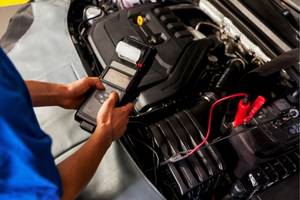Introduction
In today's automotive landscape, the Engine Control Module (ECM) is the unknown hero making sure your vehicle runs smoothly. With the increasing complications of ECM systems, owning a reliable skill set for professional ECM computer repair is necessary. This guide will walk you through the important steps of diagnosing, repairing, updating, testing, and maintaining ECM computers. Let's get started on this journey to mastering ECM repairs!
1. Diagnose ECM Computer Issues Accurately
The first step in any professional ECM computer repair process is accurately diagnosing the issue. It's a bit like being a detective—you're looking for clues that point towards the problem.
The Check Engine Light is your first clue. When this little warning light pops up on your dashboard, it's the ECM computer saying, "Hey, I've found a problem!" Now, it's your job to figure out what that problem is.
Get your hands on a reliable OBD-II scanner. This tool will be your best friend in the diagnosis process. It reads the trouble codes that the ECM computer generates when it detects an issue. Brands like Autel, Innova, and Foxwell offer some of the best OBD-II scanners in the game.
Understanding the trouble codes is the next piece of the puzzle. Each code corresponds to a specific issue in the ECM computer. For instance, a P0201 code indicates a problem with Injector Circuit/Open - Cylinder 1. So, if you see this code, you know you're dealing with an issue in the fuel injector circuit.
Take note of any symptoms. Is the engine misfiring? Is fuel economy suffering? Are there unusual noises? All these symptoms can provide valuable insight into what's going wrong.
Remember, the more accurate your diagnosis, the smoother your professional ECM computer repair process will be. So, arm yourself with a reliable OBD-II scanner, understand those trouble codes, and always pay attention to symptoms—it's the Sherlock Holmes method for ECM computer repair! And who knows, you might just solve the mystery of the Check Engine Light.
2. Replace Faulty ECM Components
Once you've played detective and pinpointed the problem, it's time to roll up your sleeves and get to work. In the world of professional ECM computer repair, you'll often find that replacing faulty components is the best course of action.
Know Your Components
Being familiar with the key components of an ECM computer can save you a lot of time. Every ECM computer contains a microprocessor, memory chips, and input and output interfaces. Each of these parts plays a crucial role in the functioning of your vehicle. For instance, the microprocessor is the brain of the operation—it makes important decisions based on the data it receives.
Spotting Faulty Components
Faulty components can be a major culprit behind ECM issues. It's a bit like having a bad apple in a fruit basket—it spoils the whole bunch. Often, poor engine performance or strange behavior from your vehicle can be traced back to a single faulty component.
The Replacement Process
Ready to replace that faulty component? Great, but remember, safety first! Always disconnect your vehicle's battery before you start. This prevents any accidental short circuits during the replacement process.
Next, remove the existing component. Sometimes this is as simple as unscrewing a few bolts. Other times, it may require more complex maneuvers. It’s a good idea to take pictures as you go along—they can act as a handy guide when you're installing the new component.
Finally, install your new component, reassemble the ECM computer, and reconnect the battery. Start your engine and see if the problem is resolved. If everything goes well, you've just completed a successful professional ECM computer repair!
Remember, replacing faulty components is a key skill in the arsenal of any professional ECM computer repair technician. So don't shy away from getting your hands dirty—you'll be amazed at what you can fix with a little know-how and some elbow grease.
3. Update ECM Software Efficiently
Stepping into the software side of things, let's discuss how to keep your ECM computer running smoothly with timely software updates. After all, even the best of hardware can falter without the right software to back it up!
Understanding ECM Software
Like any computer, your ECM computer runs on software. This software controls various functions of your vehicle, from fuel injection rates to emission control—and a whole lot more. But, just like your smartphone apps, sometimes this software needs an update. That's where professional ECM computer repair comes into play.
Why Update?
You might be wondering, why bother with software updates? Well, manufacturers release updates to fix bugs, improve performance, and sometimes even add new features. Not keeping your ECM software updated can lead to decreased performance or even cause certain functions to stop working altogether. So, think of it as giving your car a little TLC.
The Update Process
Armed with a laptop and the right software, updating your ECM can be as easy as pie. Here's how:
Connect your ECM to your laptop: Use a standard OBD-II connector for this step. It's a universal connector found in most vehicles manufactured after 1996.
Run the software: There's a variety of software available for this task. Some are generic, while others are specific to certain brands. Whichever software you use, ensure it's up-to-date and compatible with your vehicle.
Follow the prompts: Once the software is running, it should guide you through the update process. Typically, this involves downloading the update from the manufacturer and installing it on your ECM.
Reboot and test: After the update is installed, reboot your ECM and start your vehicle. Check to see if everything is working as it should.
And voila! You've just completed a software update as part of your professional ECM computer repair tasks. Just remember, like any other software, ECM software should be updated regularly to keep your vehicle running in tip-top shape. So, when was the last time you updated yours?
4. Test ECM Computer Post-Repair
After you've successfully updated your ECM software, the next step in professional ECM computer repair is to test the system. Just like a chef tasting the dish before serving, this process ensures that your repair job has been successful. Let's explore the world of post-repair testing, shall we?
The Importance of Testing
Testing is more than just a quick engine rev—it's an integral part of the repair process. It helps you verify that the issues you identified at the start have been resolved, and that your car is back to its optimal performance. In other words, it's your way of saying, "Job well done!"
The Testing Process
So, how do you go about testing your ECM computer post-repair? It's not rocket science—here's a simple guide:
Start your car: Listen for any unusual noises. A smooth, steady hum is a good sign, while knocking or sputtering could indicate a problem.
Check your dashboard: Look for any warning lights. If any are lit, it could mean there's still an issue that needs addressing.
Take a test drive: This allows you to see how your car performs under different conditions. Pay attention to how your vehicle accelerates, brakes, and handles.
Use diagnostic tools: These tools can help identify issues that may not be immediately apparent. They give you a more detailed picture of your vehicle's health.
The Final Verdict
If your vehicle passes these tests with flying colors, congratulations! You've successfully completed a professional ECM computer repair. If not, don't worry. It simply means there's more work to be done. Remember, every problem has a solution—you just need to find it.
So, the next time you're faced with an ECM computer issue, remember: diagnose, repair, update, test, and maintain. After all, a well-functioning ECM is the key to a happy vehicle, and a happy vehicle makes for a happy driver.
5. Maintain ECM Computer for Longevity
After completing the professional ECM computer repair and acing the post-repair tests, it's time to focus on maintenance. Think of it as the TLC your ECM computer needs to perform its best for years to come. Ready to dive in? Let's go.
Why Maintenance Matters
Keeping your ECM computer in tip-top shape isn't just about prolonging its lifespan—it's also about ensuring your vehicle performs optimally. Regular maintenance helps prevent issues from cropping up in the first place. It's like going to the dentist regularly instead of waiting for cavities to form.
Maintenance Tips and Tricks
Now that we've established why maintenance is essential, let's talk about how you can maintain your ECM computer:
Regularly check for updates: Software updates often come with bug fixes and improvements. Regularly updating your ECM software helps keep things running smoothly.
Don't ignore warning signs: If your vehicle starts behaving oddly, don't shrug it off. It could be a sign that your ECM computer needs attention.
Clean and inspect: Regularly clean your ECM computer and inspect it for any signs of damage. A clean, well-maintained ECM is less likely to run into issues.
Schedule Regular Diagnostics: Regular diagnostic checks can help identify potential issues before they become actual problems. Prevention is better than cure, after all.
In Conclusion...
Maintenance is the secret ingredient in the recipe for professional ECM computer repair. It keeps your ECM in top-notch condition, prolongs its lifespan, and ensures your vehicle runs like a dream. So, treat your ECM computer with a little tender loving care and it will repay you with years of reliable service. A well-maintained ECM computer, after all, is a happy ECM computer.
Conclusion
Mastering the art of ECM computer repair is a valuable skill that makes sure your vehicle remains reliable and efficient. By following the steps highlighted in this guide—diagnosing issues accurately, replacing faulty components, updating software, testing post-repair, and maintaining the ECM—you can handle ECM problems with confidence. Remember, a well-maintained ECM is the cornerstone of a well-functioning vehicle. Happy repairing!
FAQs on
Proven Techniques for Professional ECM Computer Repair in 2025
-
1. What is an ECM, and why is it important?
Ans.
The Engine Control Module (ECM) is the computer that manages your vehicle's engine performance. It controls several functions such as fuel injection, ignition timing, and emissions. A well-functioning ECM makes sure your vehicle runs efficiently and reliably.
-
2. How do I diagnose an ECM issue?
Ans.
Start by using an OBD-II scanner to read trouble codes from the ECM. These codes indicate particular problems within the system. Pay attention to symptoms like engine misfires, poor fuel economy, or uncommon noises, which can provide additional clues.
-
3. Can I replace ECM components myself?
Ans.
Yes, with the right tools and knowledge, you can replace faulty ECM components. Make sure you disconnect the vehicle's battery before starting, take pictures during disassembly, and follow the proper procedures for installing new parts.
-
4. Why are software updates important for ECMs?
Ans.
Software updates fix bugs, enhance performance, and sometimes add new features. Keeping your ECM software up-to-date makes sure your vehicle operates at its best and prevents any possible issues from outdated software.
-
5. What should I do after repairing my ECM?
Ans.
After repairing your ECM, conduct complete tests. Start the engine, check for warning lights, take a test drive, and use diagnostic tools to make sure everything is functioning correctly. This confirms that your repairs were successful.
-
6. How can I maintain my ECM for longevity?
Ans.
Regular maintenance is key. Keep your ECM software updated, don’t ignore warning signs, clean and inspect the ECM regularly, and schedule periodic diagnostic checks. This dynamic approach helps prevent issues and extends the ECM’s lifespan.


